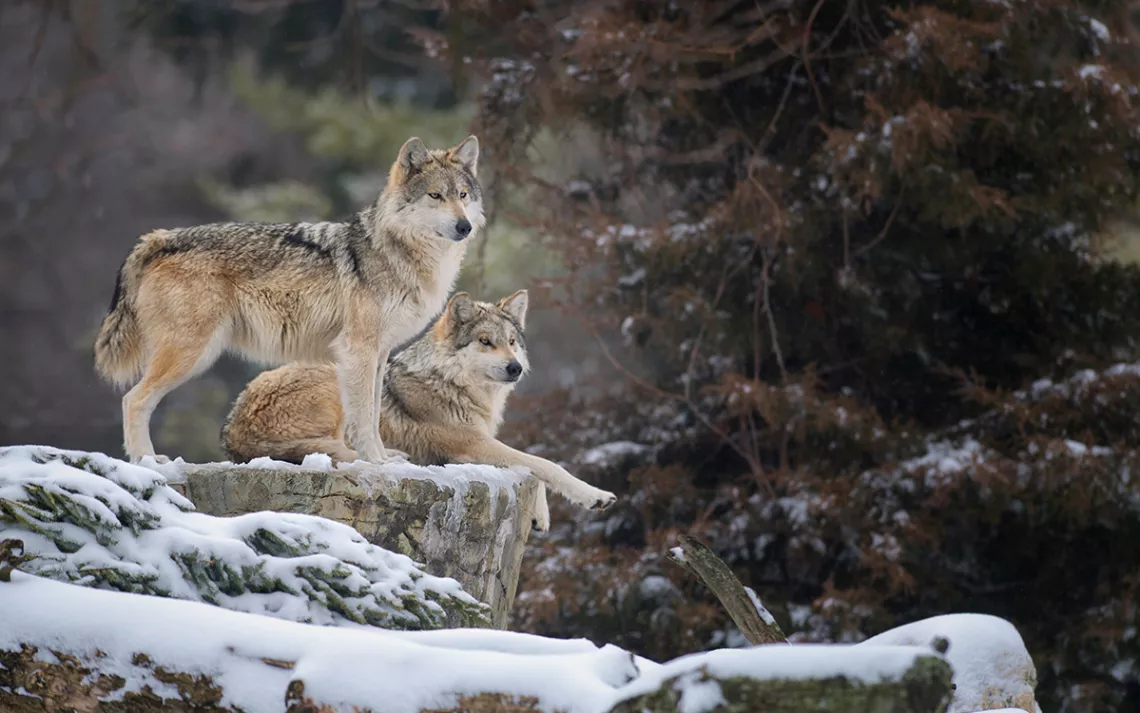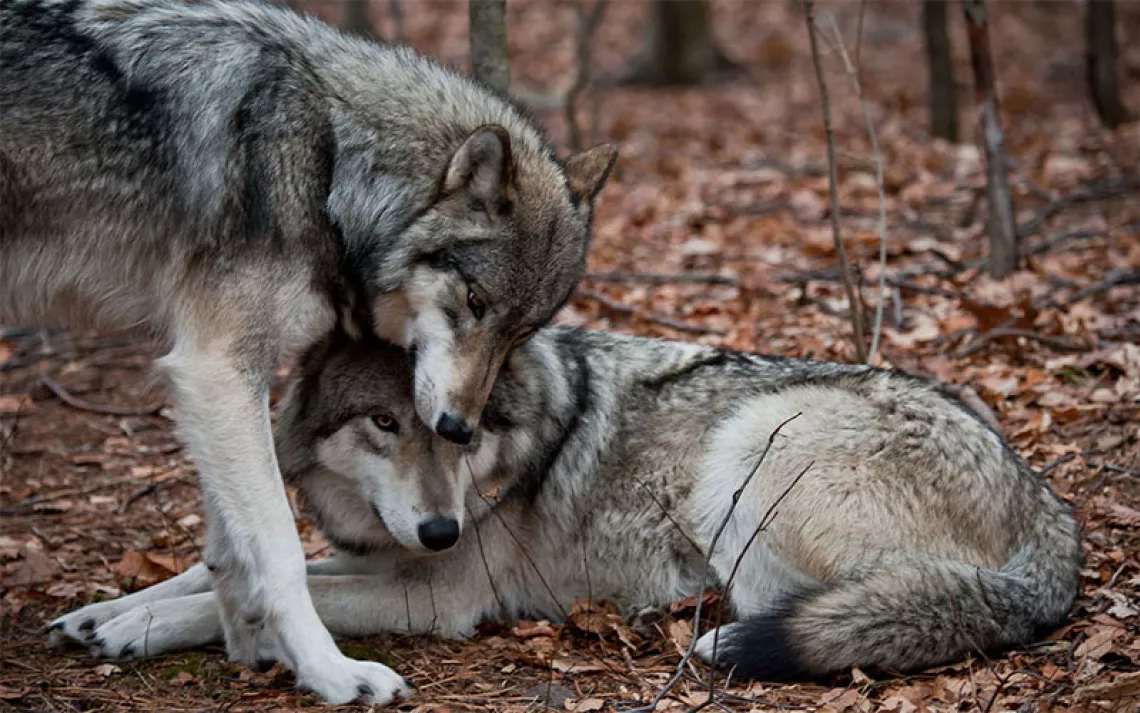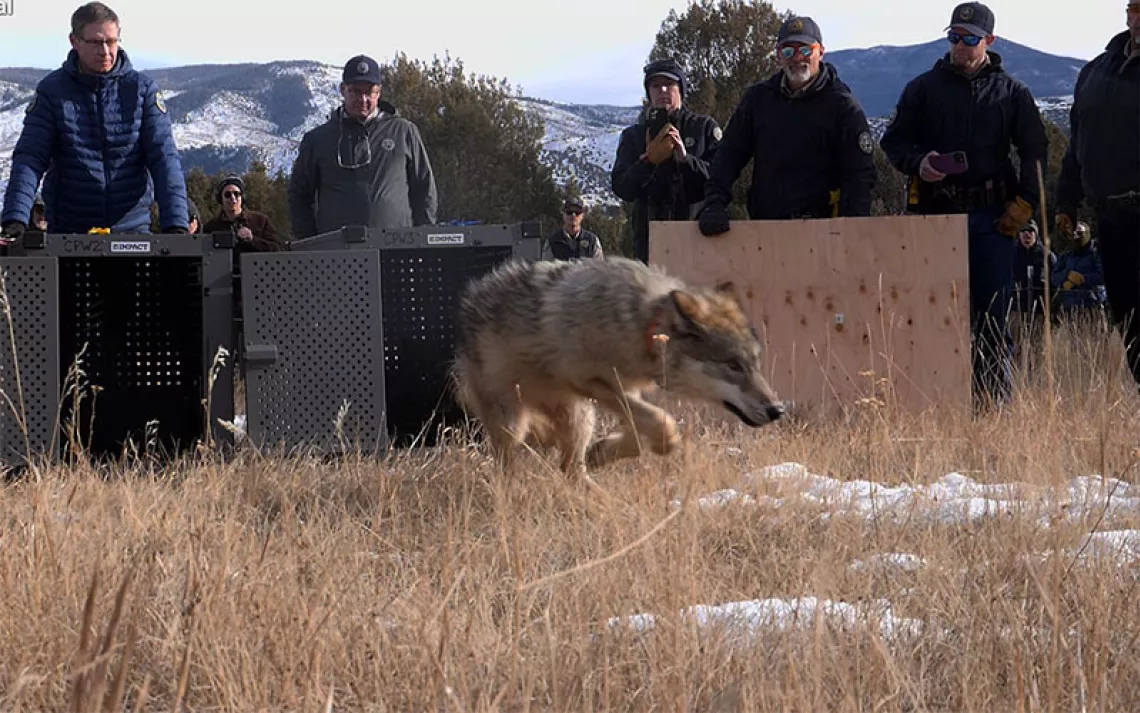Killing of Mexican Wolf Highlights Why Recovery Is Failing
Here are three key things that conservationists say need to happen to turn things around

Pair of Mexican gray wolves (Canis lupus) on a snowy ledge. | Photo by gnagel/iStock
Advocates and conservationists are increasingly worried about the plight of critically endangered Mexican wolves. While the wild population, which spans eastern Arizona and western New Mexico, has grown slightly, recovery has been slow and incremental. And the recent death of a genetically valuable male last month in New Mexico highlights why.
The US Fish and Wildlife Service is failing to protect wolves against even the most basic threats, such as illegal killing. Over the years, conservation groups have tried to force FWS to do its job, primarily using the courts. Some have sued the agency at least half a dozen times for failing to comply with the Endangered Species Act and the National Environmental Policy Act.
For its part, FWS has largely evaded many of the recommendations biologists and conservationists have put forward: a population of at least 750 individuals, spread across at least three distinct yet connected populations, and frequent genetic exchange. These goals were instead significantly reduced in the agency’s final plan, and recovery has been elusive. Now advocates are wondering what can be done to fully restore wolf populations in the Southwest while working within the agency’s narrow view of recovery.
“The science is clear,” said Greta Anderson, a deputy director at Western Watersheds Project who tracks Mexican wolf issues. “What Fish and Wildlife Service is supposed to be doing is clear. Why they aren’t doing it is a mystery.”
Excessive killing
David Parsons, a FWS Mexican wolf biologist for over three decades, has an idea why. He says that the management of Mexican wolves has been mired in a history of mistakes and unaccountability, from state governors using their power to contradict the guidance of wolf biologists to lax enforcement of existing protections.
“The US Fish and Wildlife Service has essentially been captured by the pressure from … the states,” said Parsons. “If they had the choice, they probably wouldn't want wolf recovery at all.”
However, Parsons and several other prominent conservationists say there are steps the federal wildlife managers can take immediately to improve the odds of recovery. One of them is addressing human-caused mortality. Since 1998, at least 240 Mexican wolves have been killed in Arizona and New Mexico, with 131 of those being illegal. A 2021 court order instructed FWS to do more to address illegal killing, a.k.a. poaching. In response, the agency released a revised rule this past summer that increases enforcement, education, and outreach initiatives for hunters.
But that hasn’t deterred people from killing wolves. This year alone, at least three Mexican wolves have been killed in the Southwest. The most recent killing of a breeding male in western New Mexico will have a detrimental impact on his pack, said Anderson, and on the recovering population writ large. The wolf, called m1693 by wildlife managers (and Grenville by the Endangered Wolf Center in Missouri, where he was born) was wearing a telemetry device that allows ranchers to track collared wolves with FWS receivers.
The practice is supposed to be used so that ranchers will steer clear of wolves to avoid conflicts, but advocates have denounced it as a way of giving ranchers, who largely opposed wolf recovery, access to tracking data.
Parsons suggests that if the agency really wanted to address illegal killing, it could start by doing a better job of enforcing its own rules. It is illegal to kill a threatened or endangered species unless one has a special permit. The penalty for killing one without a permit can result in jail time and hefty fines, but with Mexican wolves, convictions are rare, and there are two reasons why, adds Parsons.
First, there’s the McKittrick Policy, which allows perpetrators to avoid prosecution if they say they didn’t know the species they killed was listed under the Endangered Species Act. The second is mistaken identity. Wolf killers often claim that they thought their target was a coyote. But solving both of these issues is rather simple.
“[G]iven that the common excuse is, ‘I thought it was a coyote,’ two things can happen. . . . One is to designate coyotes within the areas occupied by Mexican wolves as threatened or endangered. . . . Or a much easier policy than actually going through that formal listing process is . . . to outlaw the shooting of coyotes in designated . . . areas,” said Parsons. For the policy issue, he says, “all that’s needed is for Attorney General Merrick Garland to just strike it off the books.”
Limited genetics
The wanton killing of wolves exacerbates an even greater problem. Since only seven Mexican wolves were alive when recovery efforts started, inbreeding issues have plagued the program to bring them back since the beginning. Currently, the agency releases captive-born pups into wild dens with pups of similar age, a process called cross-fostering.
However, Michael Robinson, a senior conservation advocate at the Tucson-based Center for Biological Diversity, says that the program is fraught with issues. For example, of the 72 pups released between 2016 and 2021, only 12 were known to be alive today; five-sixths of the total were dead or missing. For Robinson and other wolf activists, this is a low success rate for a program that’s meant to alleviate one of the biggest threats to a successful recovery.
A better way to help assess and boost genetics, he says, would be to release pups with their parents, which could breed much quicker than the two years it takes pups to reach maturity. Records from FWS show that when they released family groups together in suitable areas, the survival rate was much higher.

Sign up to receive Sierra News & Views
Get articles like this one sent directly to your inbox weekly.
With this action you affirm you want to receive Sierra Club communications and may vote on policy designated by the Sierra Club Board.
“This is one of several instances in which Fish and Wildlife unpersuasively cloaks its political-based mismanagement in the mantle of science,” said Robinson. “Scientists have known for a century that wolves’ family bonds are key to their success. There is no biological rationale for not releasing the moms, dads, and pups together as families.”
Interstate barrier
Carlos Carroll is a biologist who served on an earlier recovery team, where he specialized in population viability. He says complete recovery won’t happen until wolves are allowed to travel north of Interstate 40. Currently, wildlife managers are directed to remove wolves that venture north of the highway, which cuts across north-central Arizona and New Mexico. Proponents of the border argue that the highway marks the northern extent of Mexican wolves’ historic range. But biologists like Carroll say that’s not how wildlife movement works.
Wolves are famous for their ability to travel great distances. At least 10 Mexican wolves have ventured north of I-40, only to be returned to their designated population area or killed, according to Emily Renn, the executive director of the Grand Canyon Wolf Recovery Project. Such is the case for a male wolf named Anubis that crossed the highway at least eight times before being found dead west of Flagstaff last year.
Areas north of the Grand Canyon and southern Colorado are already ripe wolf habitat, with abundant prey, room to roam, and remote habitat to avoid conflict with ranchers, says Carroll. The chance of genetic exchange increases slightly with the reintroduction of wolves in Colorado next year, but it’s not guaranteed until FWS removes the I-40 boundary.
“Some groups like Utah and Arizona state game agencies, I believe, have argued that we need to keep those two subspecies of wolves separate,” said Carroll. “But most of the geneticists I talked to believe that it will be beneficial to have that kind of connection among the two populations in the long term.”
Legal imbroglio
Three lawsuits working their way through the courts now are meant to correct many of these issues, along with a suit of other recommendations, such as removing the Mexican wolf’s nonessential classification. The Western Environmental Law Center and Earthjustice filed separate lawsuits last month, citing much of the research conducted by Carroll and Parsons.
The crux of these lawsuits is that the agency is not using the best available science, says Tim Preso, managing attorney at Earthjustice.
In the meantime, while these cases wend their way through the courts, Mexican wolves are left in limbo, roaming the national forests of New Mexico and Arizona, but not entirely free.
“The Mexican wolf is an iconic part of our natural heritage in the American Southwest,” said Preso. “We have a real opportunity to restore it in a lasting way on the landscape, but we can't do that unless we follow the science.”
 The Magazine of The Sierra Club
The Magazine of The Sierra Club



